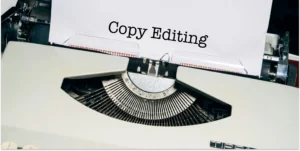The role of a copy editor has evolved significantly over the years, adapting to the changing world of publishing and content creation. Historically, copy editing as a profession grew out of the need for accuracy and clarity in printed materials. Now, a copy editor performs various tasks aside from the original ones, such as improving readability, fact-checking, adjusting syntax and structure, eliminating jargon, guaranteeing inclusivity and sensitivity, adhering to legal and ethical standards, optimizing content for SEO, and verifying hyperlink accuracy.

✅ AI Essay Writer ✅ AI Detector ✅ Plagchecker ✅ Paraphraser
✅ Summarizer ✅ Citation Generator
Historical Context
Initially, copy editing was a task performed by proofreaders or the authors themselves to correct straightforward mistakes before publication. However, as the publishing industry grew, the distinction between roles became more vivid. The modern profession of copy editing appeared in the late 19th and early 20th centuries, as newspapers and magazines sought to establish credibility and accuracy in their rapidly growing content. This era marked the specialization of the editing process, differentiating copy editors from other roles in publishing (read proofreaders and writers).

Copy Editors, Editors, and Journalists: What are the differences?
The primary difference between copy editors and editors (often referred to as substantive or developmental editors) lies in the scope of their work. You see, copy editors focus on the text at the sentence level—correcting grammar, punctuation, spelling, and keeping consistency— while editors tackle the content from a broader perspective. They work on the structure, coherence, and overall flow of a piece, often making significant changes to the content to improve readability or to align with the overall writing theme. Developmental editors dive deep into the content’s structure, improving its narrative or argumentative layout, whereas copy editors polish the final draft to make it error-free and clear.
Journalists and writers are the creators of content. Their primary role is to research, ideate, and craft stories or articles that inform, entertain, or educate the audience. In contrast, copy editors do not create original content. Instead, they refine and add to the writer’s work. A journalist or writer focuses on storytelling and information delivery, relying on creativity and investigative skills. Copy editors, on the other hand, apply a scrupulous and methodical approach to improve the text’s clarity, engagement, and correctness without altering the author’s voice or intent.
| Copy Editors | Editors | Journalists | |
|---|---|---|---|
| Main Focus | Focus on correcting grammar, punctuation, and spelling. They guard consistency, clarity, and adherence to style guides at the sentence level without altering the author’s voice. | Concentrate on structuring content, improving flow, and addressing thematic and organizational aspects. Their work includes broad content revisions, including restructuring and thematic development. | Involved in researching, creating, and presenting news and stories. Their main focus is on content creation from concept to final draft. |
| Scope of Work | Perform sentence-level revisions to make the text polished and clear for publication. | Engage in middle-stage content improvement, focusing on enriching content after its initial creation and before final polishing. | Responsible for content creation and ideation, generating the original content and narrative. |
| Skills Required | Need attention to detail, a strong grasp of language and grammar, and familiarity with various style guides. | Require creative thinking, structural analysis, and a strong understanding of narrative or argumentative coherence. | Must have investigative skills, storytelling ability, the capacity to meet deadlines, and adaptability to various topics. |
| Output | Produce polished and clear text ready for publication. | Deliver coherent, well-structured content aligned with the intended message/theme. | Produce informative, engaging, and timely articles or stories. |
| Role in Publishing Process | Represent the final stage of text refinement before publication. | Focus on content improvement in the middle stage, after initial creation and before final polishing. | Involved in the initial stage, focusing on content creation and ideation. |
| Interaction with Content | Do not alter the content’s substance or the author’s voice, focusing on clarity and correctness instead. | May significantly alter the content’s structure or approach to improve its impact. | Generate the original content and narrative, starting the content creation process. |
| Career Path | Often requires a degree in English, Journalism, or related fields, with a focus on language mastery. | May need a background in creative writing, literature, or journalism with an emphasis on content development. | Require strong research and writing skills, often with a background in journalism, communications, or related fields. |
What Qualifications Does a Copy Editing Job Require?
The qualifications for a copy editing job include a blend of linguistic proficiency, technical know-how, and interpersonal skills. While formal education in copy editing is not a strict imperative, a foundational understanding and mastery over the language being edited—often English—are paramount. Moreover, such linguistic ability covers not just the basics of grammar and syntax but also nuances of stylistic and tonal variations that can significantly impact the readability and engagement of a text.
Prospective copy editors frequently come from academic backgrounds that emphasize strong writing and analytical skills, such as degrees in English, journalism, or communications. These disciplines provide a solid groundwork in effective communication, critical thinking, and the mechanics of writing, all of which are essential in the field of copy editing. Beyond the fundamentals of language, knowing a range of style guides (e.g., APA, Chicago, MLA, and AP) won’t hurt as well. Each guide has its conventions, and different publishers or industries may prefer one over the others. Such knowledge contributes to consistency and accuracy in editing, catering to the specific requirements of each publication.
Proficiency with editing software (such as Microsoft Word’s Track Changes, Google Docs, Adobe Acrobat, and specialized editing software like Scrivener) is increasingly important. These tools simplify the editing process and allow efficient collaboration and communication between editors, authors, and the publishing team. Therefore, technical savviness with these platforms increases copy editor’s efficiency and adaptability.
Furthermore, excellent interpersonal skills are needed for a successful career in copy editing too. The role often requires direct communication with authors, publishers, and other stakeholders in the publishing process. Thus, being able to provide constructive feedback, negotiate changes, and maintain a positive working relationship, all while respecting the author’s voice and intent, is a delicate balance that demands tact, diplomacy, and empathy. The ability to collaborate effectively and adapt to different communication styles and preferences is just as important as technical editing skills.
In summary, while a specific degree in copy editing is not mandatory, the role demands a vast skill set that includes a deep understanding of language, proficiency with editing tools and style guides, and strong interpersonal abilities for effective collaboration. These qualifications guarantee that a professional can refine and improve text to meet the highest standards of clarity, coherence, and readability, making them an invaluable asset in the publishing industry.
The Evolution of the Profession
The digital age has introduced new dimensions to the copy editor’s role. With the rise of online publishing, SEO (Search Engine Optimization), multimedia elements, and hyperlinked content, copy editors now often find themselves making sure that texts are not only well-written and clear but also optimized for digital platforms. This includes understanding the basics of SEO, making content accessible and engaging across different devices, and even verifying that hyperlinks are accurate and relevant. The table below highlights the various functions of traditional editors versus modern-day copy editors, showing the evolution of the profession in the context of the digital age:
| Function | Traditional Editors | Modern-Day Copy Editors |
|---|---|---|
| 📝 Focus on Language | Concentrated on grammar, spelling, punctuation, and stylistic consistency. | Continue to focus on these traditional aspects but with added emphasis on clarity and engagement for digital readability. |
| 📚 Publishing Platforms | Primarily focused on print media: books, newspapers, and magazines. | Work across a variety of platforms including websites, blogs, e-books, and social media. |
| 🔍 Content Optimization | Content optimization was not a primary concern. | Must understand SEO principles to raise the visibility and searchability of online content. |
| 🖼️ Multimedia Integration | Limited to none, as the content was mostly textual. | The text must integrate well with multimedia elements like images, videos, and infographics, boosting user engagement. |
| 🔗 Hyperlinked Content | Non-existent in print media. | Verify and check that hyperlinks are accurate, relevant, and add value to the text, raising the quality of the reader’s experience. |
| 📲 Accessibility | Accessibility considerations were limited to print formats. | Make content accessible across various devices and compliant with web accessibility standards (e.g., WCAG). |
| 👥 Collaboration and Feedback | Mostly done through direct, often in-person, communication with authors and teams. | Uses digital tools and platforms for collaboration, feedback, and edits, allowing for remote work and immediate revisions. |
| 🌐 Content Distribution | Distribution was through physical copies or via traditional broadcasting. | Digital distribution through websites, content management systems, and social media platforms. |
| 📊 Market Research | Focused on print circulation numbers and reader demographics. | Involves analyzing web traffic, engagement metrics, and audience behavior to inform content strategy. |
So, What Does a Copy Editor Do?
As you’ve already learned, a copy editor is an important figure in publishing and content creation, serving as the last line of defense before a piece of writing reaches its audience. Their role blends attention to detail with a deep understanding of language and style. By refining and polishing text, copy editors give the final product that is free from errors, clear, logical, and engaging. Here are some of the key duties that copy editors typically perform:
- Grammar, Punctuation, and Spelling Checks: Making sure the text follows the rules of grammar and is free from punctuation and spelling mistakes.
- Style Consistency: Applying the specific style guide relevant to the project (e.g., APA, Chicago, MLA, or AP) for consistency in formatting, citations, and usage throughout the text.
- Readability Enhancement: Improving the flow and readability of the text, making complex information accessible and engaging for the target audience.
- Fact-Checking: Verifying the accuracy of factual statements to build the credibility and reliability of the content.
- Syntax and Structure: Adjusting sentence structure and syntax to improve clarity and impact, without changing the author’s intended voice or message.
- Elimination of Jargon: Simplifying or explaining technical terms and jargon, especially when the content is aimed at a general audience.
- Inclusivity and Sensitivity Review: Keeping language use inclusive and sensitive, avoiding biases, stereotypes, or phrasing that could be considered offensive.
- Adherence to Legal and Ethical Standards: Checking the content for potential legal issues, such as copyright infringement or libel.
- SEO Optimization: For digital content, optimizing the text for search engines, including the use of relevant keywords, without compromising the quality or readability of the content.
- Hyperlink Accuracy: For online publications, verifying that hyperlinks are accurate, functional, and relevant to the context of the text.
Conclusion
As the tech era continues to bloom, so too does the role of the copy editor, expanding to include elements of SEO optimization, multimedia integration, and web accessibility. Despite these changes, the core responsibilities of improving readability, maintaining accuracy and stylistic consistency remain unchanged. The profession stands as a testament to the importance of clear and effective communication in an increasingly information-saturated world.
FAQ
Follow us on Reddit for more insights and updates.




Comments (0)
Welcome to A*Help comments!
We’re all about debate and discussion at A*Help.
We value the diverse opinions of users, so you may find points of view that you don’t agree with. And that’s cool. However, there are certain things we’re not OK with: attempts to manipulate our data in any way, for example, or the posting of discriminative, offensive, hateful, or disparaging material.